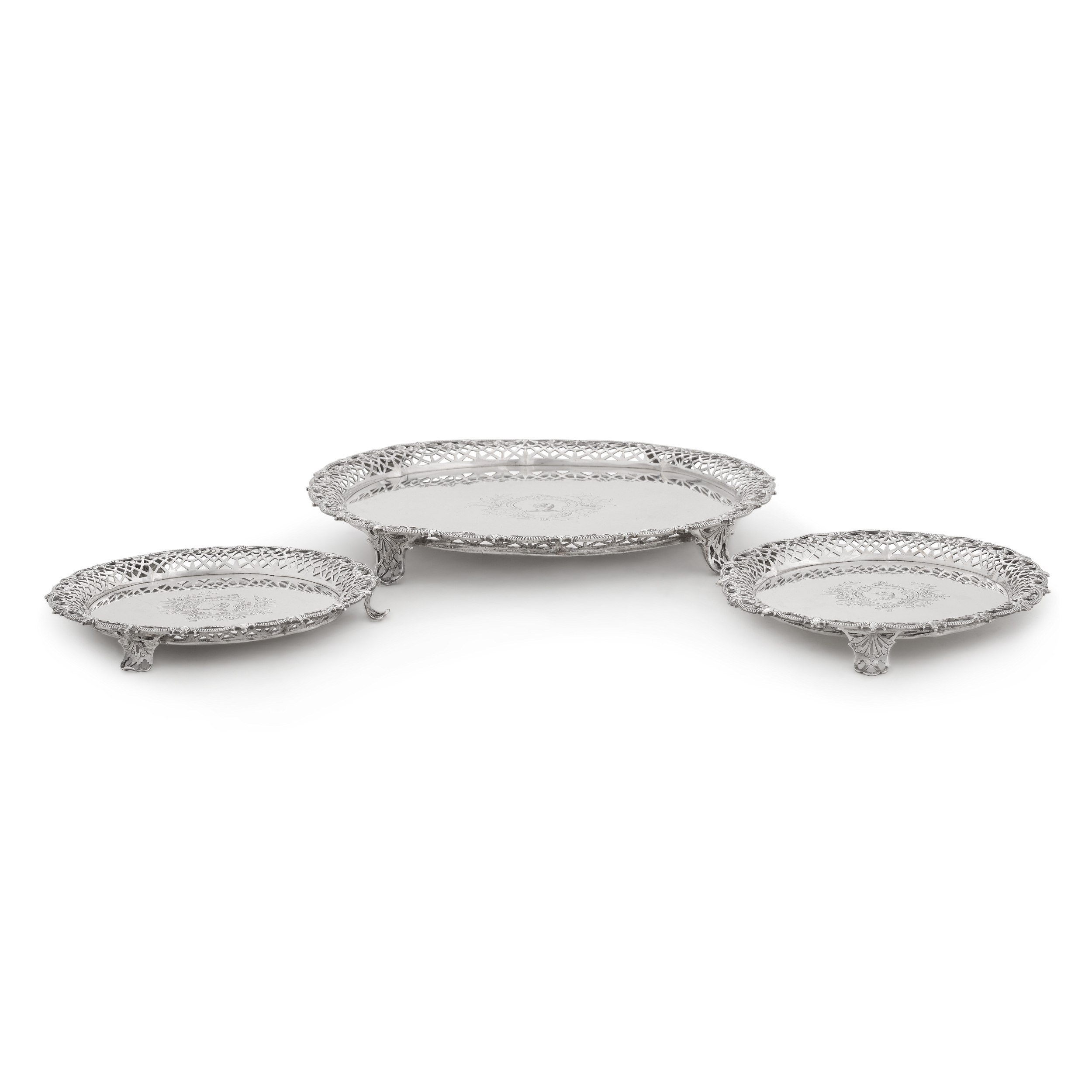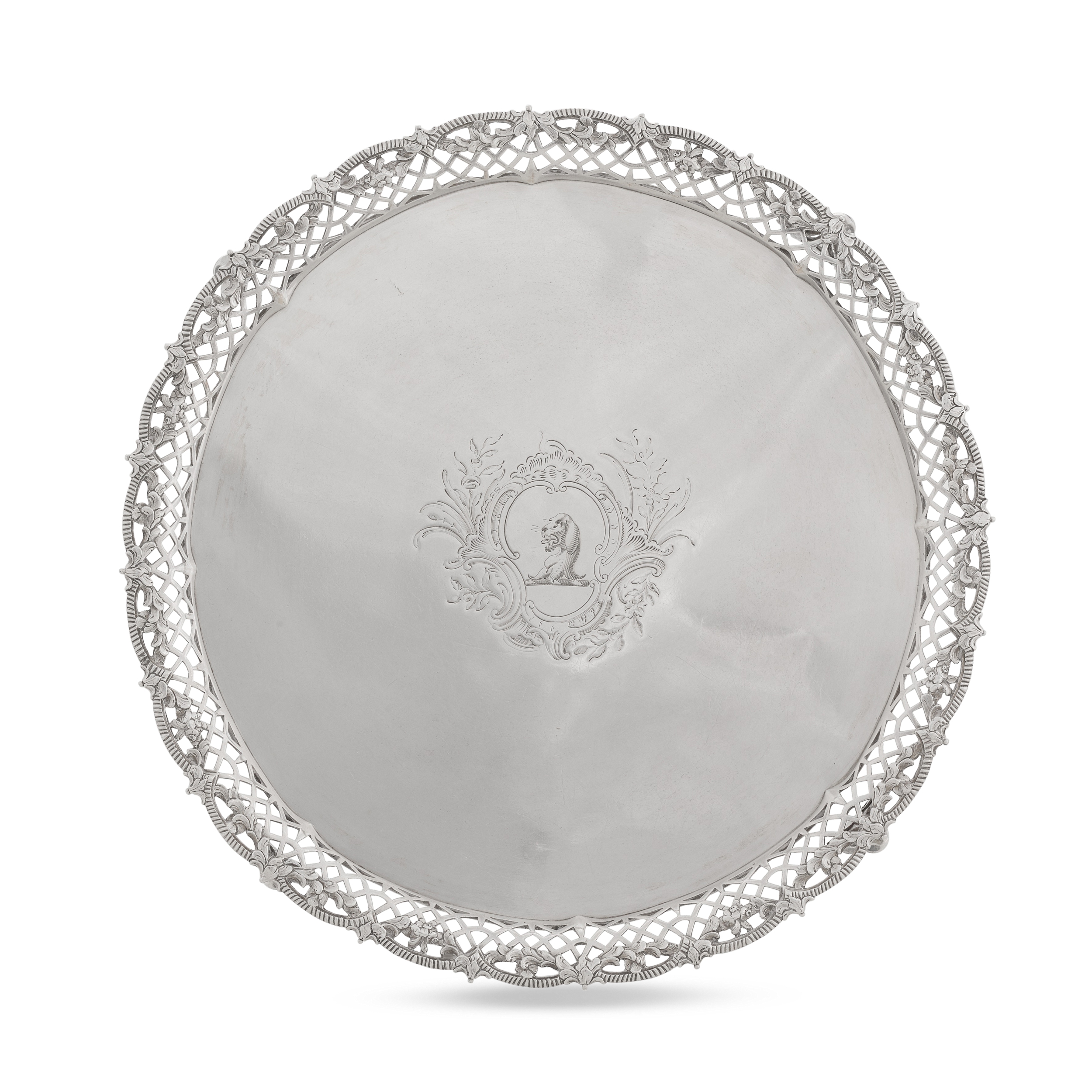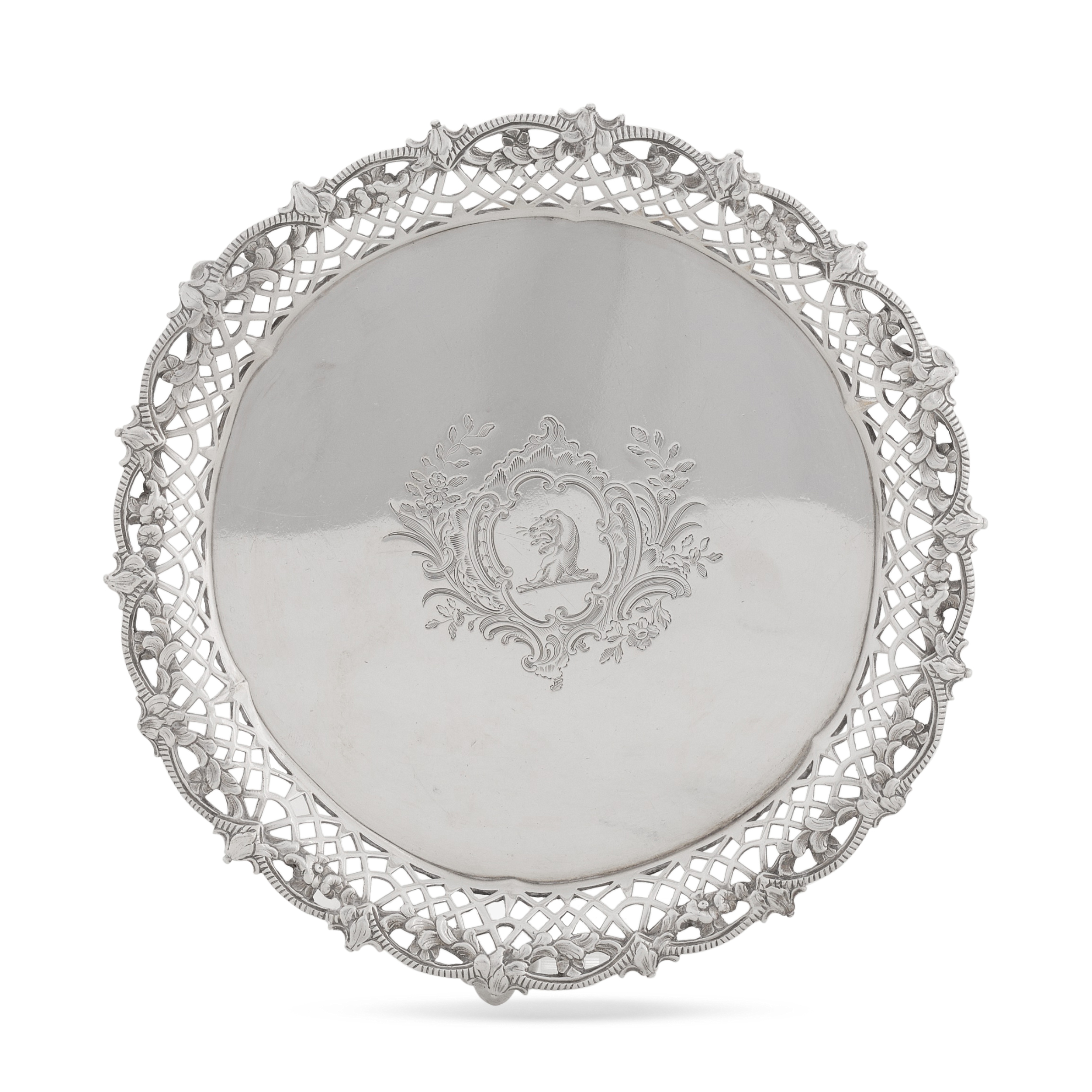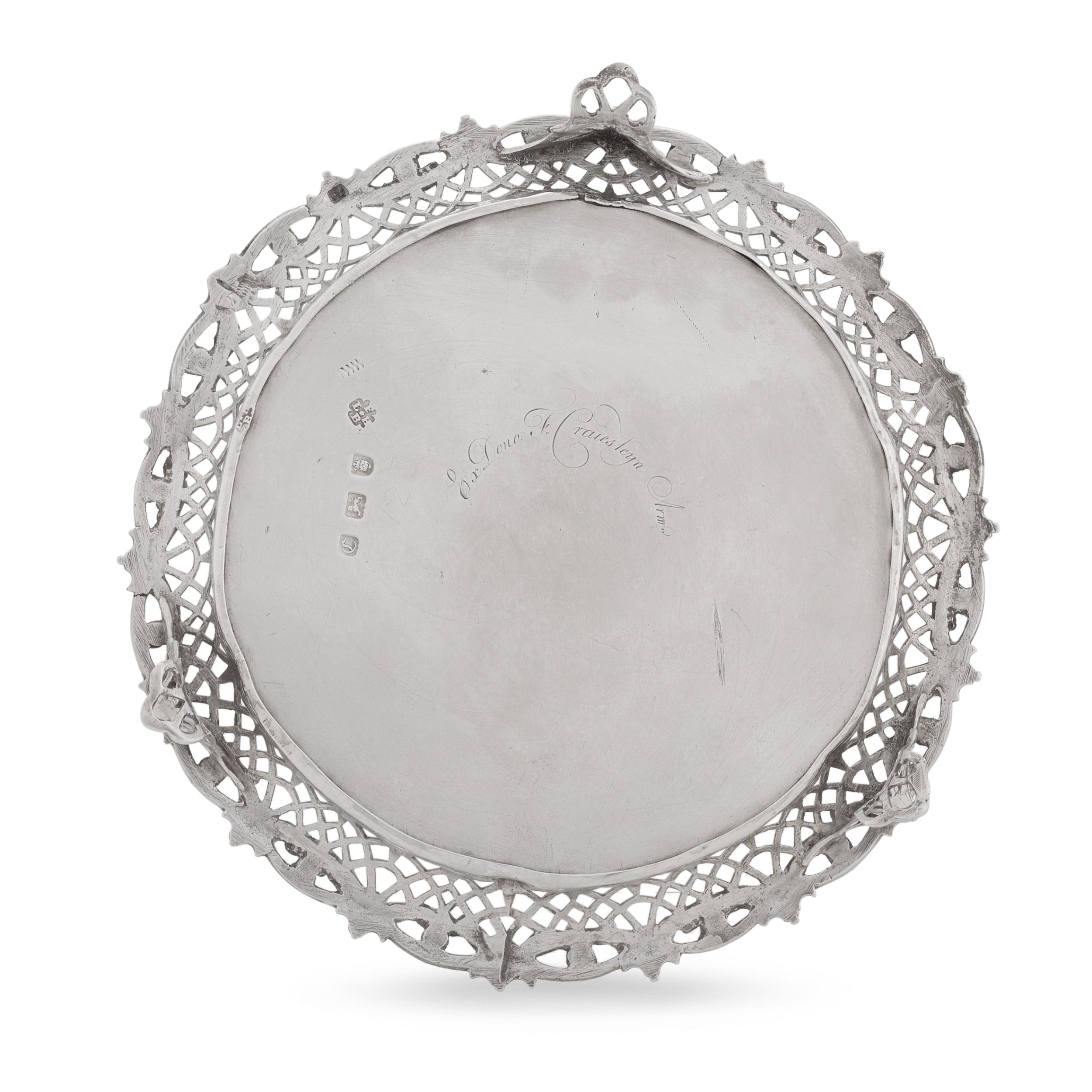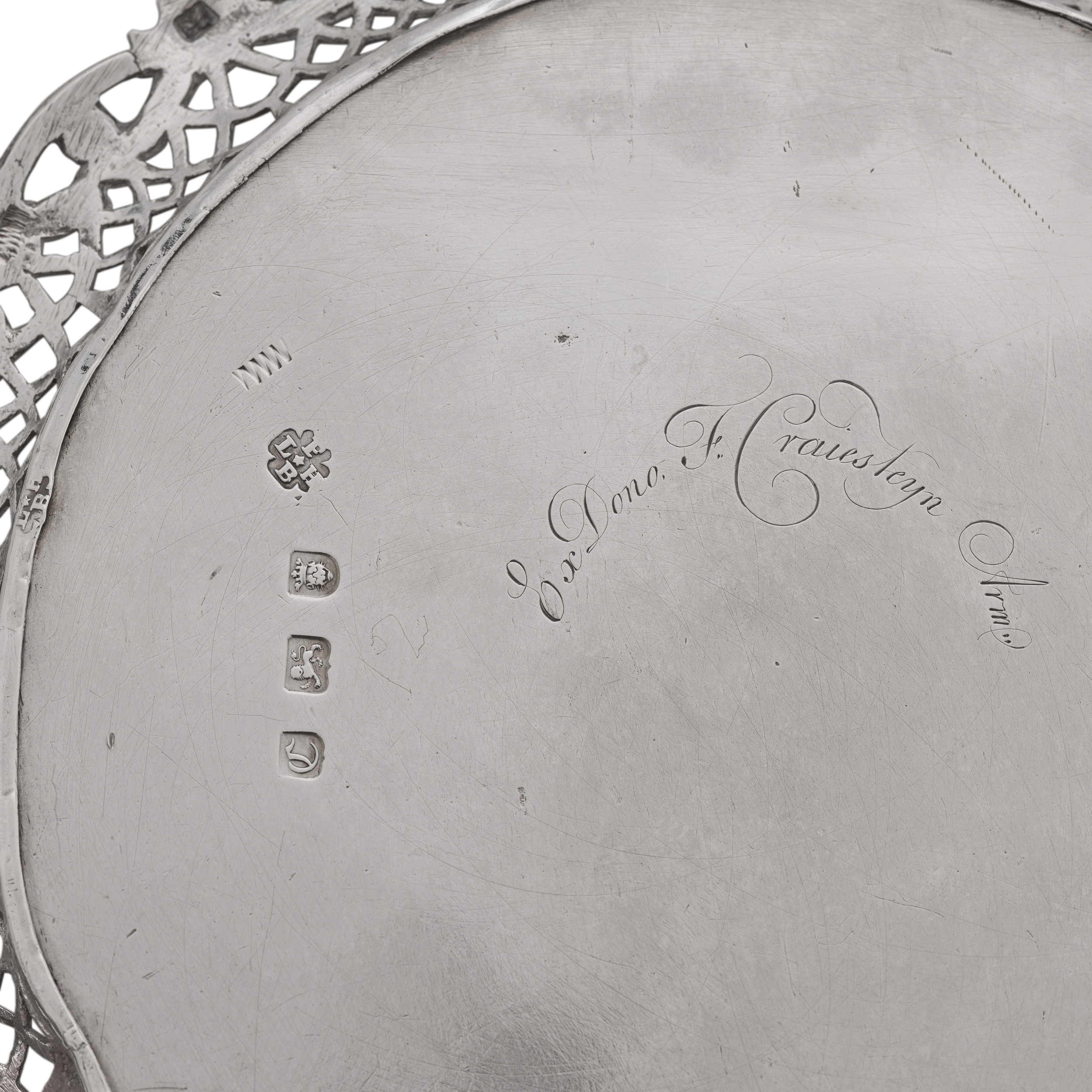26
A suite of George II silver waiters and salver, Herne & Butty, London, 1758
A suite of George II silver waiters and salver
Herne & Butty, London, 1758
circular, the openwork borders with floral swags, the centres crested, the undersides engraved 'Ex Dono F. Craiensteyn Arm',
diameter of the salver 31cm., 12 1/4in.
1802gr., 58oz.
Provenance
Sotheby's, London, 24 October 1985, lot 409
Catalogue note
Francis Craiesteyn : business and family
Francis Craiesteyn (1695-1758) and his brother and business partner, Abraham (d. 1754) were the sons of Abraham Craiesteyn (1666-1732) and his wife, Rebecca (née van der Mersch, 1658-1744). Natives of Haarlem, they flourished during the first half of the 18th century as merchants in the City of London where they established themselves in Laurence Pountney Lane. The Craiesteyns were prominent members of the close-knit Dutch community in the City. Another was the merchant Gerard Roeters (d. 1731),1 who in 1715 moved from Amsterdam to London, purchased a country house in Twickenham, was knighted in 1723 and who in 1716 married the Craiesteyn brothers’ sister, Mary (d. 1752).2
Following the death of the younger Abraham Craiesteyn in 1754, the text of his will was published in several London journals. This unusual step was likely to have been taken on account of the enormous sums he left to his two main beneficiaries; his wife, Anne (1715-?1764),3 who received £100,000 (equivalent now to about £11,000,000), and his brother and sole executor, £80,000 (equivalent to about £9,000,000). Other beneficiaries included Craiesteyn’s cousin, Jacob Van Der Graas of Haarlem and his wife, Cornelia, each of whom was to receive £3,000.4
In Francis Craiesteyn’s will, signed on 27 June 1755 and proved on 19 October 1758, the largest bequest of many, both in Holland and England, was to the same Jacob Van Der Graas and his wife: ‘Item I Give and bequeath to my Cousin Jacob Vander Graas of Haarlem in Holland and Cornelia his Wife (formerly Cornelia Craiesteyn) and to the Survivor of them the sum of thirty thousand pounds.’ Another bequest in Francis Craiesteyn’s will, which accounts for the inscriptions on these salvers, reads as follows: ‘Item I give and bequeath to such Gentlemen as shall be directors of the Equivalent Company at the time of my death and also to . . . James Mathias their secretary twenty Guineas each to buy a piece of plate with an inscription to be engraved thereon signifying the same to be a gift from me as a token of my esteem and respect for them.’
In addition to his business dealings, Francis Craiesteyn was also a governor of five London hospitals, including St. Thomas’s, to each of whom he willed £1,000.5 Like his parents and brother, Abraham, he was buried in the Dutch Church, Austin Friars, Broad Street, City of London.6
Equivalent Company
For the connection between the Equivalent Company and the ongoing business known as the Royal Bank of Scotland, see NatWest Group, Equivalent Company (1721-1851) : Background history.7
Notes
1. ‘This Evening the Corpse of Sir Gerard Roeters, Knt. a Dutch Merchant, after having lain in State in Turners-Hall in Philpot-Lane, is to be interr’d with great Funeral Pomp, at St. Martin Orgar’s in Cannon-street, and the Pall to be supported by the following eminent Dutch Merchants, viz. Mr. Clement Boehm, Mr. Abraham Derhetrius, Mr. Christopher Oliver, Mr. Abraham Crop, Mr. Wm. Van Vollenhoven, and Mr. Henry Thefingh.’ (The London Evening-Post, London, Thursday-Saturday, 8-10 April 1731, p. 1b)
2. ‘Last Monday Night was buried in St. Martin Orgar’s Church, from Founders Hall, Lady Roeters, Relict of Sir Gerard Roeters, Knt. late an eminent Merchant of this City, and Sister to Mr. Craesteyn [sic], an eminent Merchant; Her Pall was supported by the following Gentlemen, viz. William Hunt, John Edwards, Abraham d’Metrus, Benjamin Longuet, Henry Spurling, and Joseph South, Esqrs.’ (The General Advertiser, London, Wednesday, 29 January 1752, p. 1b)
3. The younger Abraham Craiesteyn was married at Bath Abbey, Bath, Somerset on 13 April 1749 to Anne Colborne. Died: ‘10 [May 1764] Mrs Craisteyn, at Bath, supposed to be worth 150,000£.’ (The Gentleman’s Magazine, London, May 1764, p. 250b)
4. The Universal Magazine, supplement, London, December 1754, p. 329; The London Magazine, London, January 1755, p. 91; The Public Advertiser, London, Monday, 27 January 1755, pp. 1c/2a. Abraham Craiesteyn was living in Highgate at the time of signing his will on 14 November 1754 (National Archives, Kew, PROB 11/812/333).
5. National Archives, Kew, PROB 11/840/467
6. William John Charles Moens, editor, The Marriage, Baptismal, and Burial Registers, 1571 to 1874, and Monumental Inscriptions, of the Dutch Reformed Church, Austin Friars, London, Lymington, 1884, pp. 167 and 171, where their coats-of-arms are reproduced.
7. https://www.natwestgroup.com/heritage/companies/equivalent-company.html, accessed 28 September 2023.
A suite of George II silver waiters and salver
Herne & Butty, London, 1758
circular, the openwork borders with floral swags, the centres crested, the undersides engraved 'Ex Dono F. Craiensteyn Arm',
diameter of the salver 31cm., 12 1/4in.
1802gr., 58oz.
Provenance
Sotheby's, London, 24 October 1985, lot 409
Catalogue note
Francis Craiesteyn : business and family
Francis Craiesteyn (1695-1758) and his brother and business partner, Abraham (d. 1754) were the sons of Abraham Craiesteyn (1666-1732) and his wife, Rebecca (née van der Mersch, 1658-1744). Natives of Haarlem, they flourished during the first half of the 18th century as merchants in the City of London where they established themselves in Laurence Pountney Lane. The Craiesteyns were prominent members of the close-knit Dutch community in the City. Another was the merchant Gerard Roeters (d. 1731),1 who in 1715 moved from Amsterdam to London, purchased a country house in Twickenham, was knighted in 1723 and who in 1716 married the Craiesteyn brothers’ sister, Mary (d. 1752).2
Following the death of the younger Abraham Craiesteyn in 1754, the text of his will was published in several London journals. This unusual step was likely to have been taken on account of the enormous sums he left to his two main beneficiaries; his wife, Anne (1715-?1764),3 who received £100,000 (equivalent now to about £11,000,000), and his brother and sole executor, £80,000 (equivalent to about £9,000,000). Other beneficiaries included Craiesteyn’s cousin, Jacob Van Der Graas of Haarlem and his wife, Cornelia, each of whom was to receive £3,000.4
In Francis Craiesteyn’s will, signed on 27 June 1755 and proved on 19 October 1758, the largest bequest of many, both in Holland and England, was to the same Jacob Van Der Graas and his wife: ‘Item I Give and bequeath to my Cousin Jacob Vander Graas of Haarlem in Holland and Cornelia his Wife (formerly Cornelia Craiesteyn) and to the Survivor of them the sum of thirty thousand pounds.’ Another bequest in Francis Craiesteyn’s will, which accounts for the inscriptions on these salvers, reads as follows: ‘Item I give and bequeath to such Gentlemen as shall be directors of the Equivalent Company at the time of my death and also to . . . James Mathias their secretary twenty Guineas each to buy a piece of plate with an inscription to be engraved thereon signifying the same to be a gift from me as a token of my esteem and respect for them.’
In addition to his business dealings, Francis Craiesteyn was also a governor of five London hospitals, including St. Thomas’s, to each of whom he willed £1,000.5 Like his parents and brother, Abraham, he was buried in the Dutch Church, Austin Friars, Broad Street, City of London.6
Equivalent Company
For the connection between the Equivalent Company and the ongoing business known as the Royal Bank of Scotland, see NatWest Group, Equivalent Company (1721-1851) : Background history.7
Notes
1. ‘This Evening the Corpse of Sir Gerard Roeters, Knt. a Dutch Merchant, after having lain in State in Turners-Hall in Philpot-Lane, is to be interr’d with great Funeral Pomp, at St. Martin Orgar’s in Cannon-street, and the Pall to be supported by the following eminent Dutch Merchants, viz. Mr. Clement Boehm, Mr. Abraham Derhetrius, Mr. Christopher Oliver, Mr. Abraham Crop, Mr. Wm. Van Vollenhoven, and Mr. Henry Thefingh.’ (The London Evening-Post, London, Thursday-Saturday, 8-10 April 1731, p. 1b)
2. ‘Last Monday Night was buried in St. Martin Orgar’s Church, from Founders Hall, Lady Roeters, Relict of Sir Gerard Roeters, Knt. late an eminent Merchant of this City, and Sister to Mr. Craesteyn [sic], an eminent Merchant; Her Pall was supported by the following Gentlemen, viz. William Hunt, John Edwards, Abraham d’Metrus, Benjamin Longuet, Henry Spurling, and Joseph South, Esqrs.’ (The General Advertiser, London, Wednesday, 29 January 1752, p. 1b)
3. The younger Abraham Craiesteyn was married at Bath Abbey, Bath, Somerset on 13 April 1749 to Anne Colborne. Died: ‘10 [May 1764] Mrs Craisteyn, at Bath, supposed to be worth 150,000£.’ (The Gentleman’s Magazine, London, May 1764, p. 250b)
4. The Universal Magazine, supplement, London, December 1754, p. 329; The London Magazine, London, January 1755, p. 91; The Public Advertiser, London, Monday, 27 January 1755, pp. 1c/2a. Abraham Craiesteyn was living in Highgate at the time of signing his will on 14 November 1754 (National Archives, Kew, PROB 11/812/333).
5. National Archives, Kew, PROB 11/840/467
6. William John Charles Moens, editor, The Marriage, Baptismal, and Burial Registers, 1571 to 1874, and Monumental Inscriptions, of the Dutch Reformed Church, Austin Friars, London, Lymington, 1884, pp. 167 and 171, where their coats-of-arms are reproduced.
7. https://www.natwestgroup.com/heritage/companies/equivalent-company.html, accessed 28 September 2023.
Classic Design: Furniture, Clocks, Silver & Ceramics
Sale Date(s)
Venue Address
General delivery information available from the auctioneer
Sotheby’s Post Sale Service teams can arrange expert delivery and convenient shipping of your property. We offer exceptional service and competitive rates whether shipping a diamond bracelet or a large piece of furniture. Fully knowledgeable on all international regulations, Sotheby's will compile a full range of services for you, including collection, packing and arranging for shipping and transit insurance worldwide. For sales in London and New York, simply provide us with your delivery address when you register for a sale. Following your purchase, we will send you a competitive and comprehensive shipping quote. For property purchased in all other salerooms, contact that office directly to arrange for the transport of your purchases.
To learn more, or if we may be of assistance contact us.











